Best wide-angle prime lens: fast and wide lenses for Canon and Nikon DSLRs
Go large on both image quality and viewing angle
Best wide-angle prime lenses for Nikon DSLRs
Here’s our top ten wide-angle prime lenses for Nikon DSLRs, based on good image quality, handling and all-round performance at an ‘affordable’ price. We’ve therefore excluded the Nikon AF-S 24mm f/1.4G ED, Nikon AF-S 28mm f/1.4E ED and Sigma 14mm f/1.8 DG HSM | A. They’re all excellent lenses but, for wide primes, they’re simply too expensive for most non-professional photographers to consider. Similarly, we’ve gone for mainstream lenses in most cases that include autofocus, although the manual-focus Zeiss Milvus 2/35mm is a notable exception, and it’s rather more compact and less expensive than other wide primes in the Milvus line-up. We’ve also included the Samyang 10mm, as it’s the only one on the list that’s designed for DX format (APS-C) cameras. There are some other interesting manual-focus wide primes for full-frame DSLRs on the market, including Irix 11mm and 15mm lenses, and the Laowa 15mm Macro. They deliver good performance and value for money, but don’t quite make it into our top ten.

1. Nikon AF-S 20mm f/1.8G ED
Specifications
Reasons to buy
Reasons to avoid
Compared with standard zooms for full-frame cameras that kick off with a 24mm focal length, this lens gives you a wider viewing angle. Considering the combination of 20mm focal length and fairly fast f/1.8 aperture, it’s quite a compact and lightweight lens. The ring-type ultrasonic autofocus system is fast and near-silent, but the rotational travel of the manual focus ring is very small, making accurate manual focusing tricky. Similarities between this lens and the Nikon 24mm (also featured) are that they both feature two ED elements, two aspherical elements and Nano Crystal Coating. At f/1.8, vignetting is very pronounced and corner-sharpness is sadly lacking. However, you only need to stop down to f/2.8 to get decent peripheral illumination, while f/4 improves sharpness across the whole frame. Color fringing can be noticeable towards the corners of the frame but barrel distortion is of a fairly low order. The competing Sigma 20mm f/1.4 Art lens offers better image quality and a faster aperture, but the Nikon lens is very much more compact and only about a third of the weight.

2. Nikon AF-S 24mm f/1.8G ED
Specifications
Reasons to buy
Reasons to avoid
Nikon makes a variety of FX standard zoom lenses with ranges of 24-70mm, 24-85mm and 24-120mm. This lens has to deliver something rather special to make you spend a considerable sum of extra money, considering there’s no gain in viewing angle. One advantage is its wider aperture rating of f/1.8, compared with the f/2.8, f/3.5 or f/4 of the zoom lenses, making it anywhere from 1.33 to 2.33 f/stops faster. Even so, it’s still two-thirds of a stop slower than the competing (and less expensive) Sigma 24mm lens. The Nikon’s construction doesn’t feel quite as robust as that of the Sigma and neither of them are weather-sealed, although the Nikon does feature a rubber sealing ring on its mounting plate. Autofocus isn’t quite as quick as in the Sigma lens but is similarly accurate. For image quality, sharpness is very good across most of the frame but drops off noticeably in the corners at wide apertures from f/1.8 to f/2.8. The prime does better than standard zooms to keep color fringing and barrel distortion to a minimum. Vignetting is very noticeable at f/1.8 but the Nano coatings do well to resist ghosting and flare.

3. Nikon AF-S 28mm f/1.8G
Specifications
Reasons to buy
Reasons to avoid
Bridging the gap between the classic 35mm wide-angle focal length and the seriously wide 24mm, this Nikon is a good compromise and retains the same f/1.8 aperture rating as its stablemates. It’s slightly larger and heavier than the Nikon 35mm lens, at 73 x 81mm and 330g, compared with 72 x 72mm and 305g, and has a bigger 67mm rather than 58mm filter thread. The lens features the same total count of 11 optical elements as the Nikon 35mm. This time, however, there are two aspherical elements rather than one, but no ED (Extra-low Dispersion) element. The 28mm also gains Nano Crystal Coat, for better reduction of ghosting and flare, but retains the same diaphragm blade count of seven. Again, it has ring-type ultrasonic autofocus and is supplied with a hood and pouch. Corner-sharpness at wide apertures proved much better than from the Nikon 35mm lens in our tests, but color fringing was a little worse. There’s less barrel distortion than from the Nikon 35mm lens, despite the wider viewing angle. True to its claims, the nano-structure coating does well to minimize ghosting and flare.
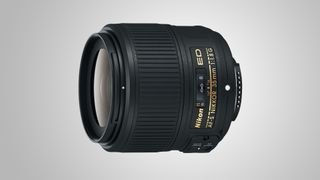
4. Nikon AF-S 35mm f/1.8G ED
Specifications
Reasons to buy
Reasons to avoid
Despite being a third of an f/stop faster than the competing Zeiss Milvus 35mm f/2 lens, the Nikon 35mm is a little smaller and less than half the weight, tipping the scales at just 305g. Typical of this this class of Nikon lens, autofocus is courtesy of a ring-type ultrasonic system. It’s fast, effective and whisper-quiet, as well as enabling full-time manual override. Manual focusing is aided by a distance scale but it’s of limited benefit, with no markings between 0.7m and infinity, the positions of which are very close in terms of rotation of the focus ring. Accurate zone focusing therefore isn’t really an option. Sharpness at the corners of the frame is a little disappointing, especially at wide apertures, but it’s pretty stellar in the central region, all the way from f/2.8 to f/11. Vignetting is a little more severe than with most competing lenses and the seven-blade diaphragm isn’t the most well-rounded. Color fringing and distortion are fairly minimal. Technically, it’s not a standout lens but many photographers love it for its mostly sharp, high-contrast image quality, and its compact, lightweight build.
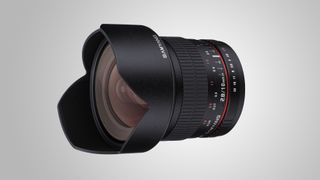
5. Samyang 10mm f/2.8 ED AS NCS CS
Specifications
Reasons to buy
Reasons to avoid
Designed exclusively for ‘DX’ or APS-C format DSLRs, this lens has an ‘effective’ focal length of 15mm in full-frame terms. It gives nearly double the viewing angle of most DX format standard zoom lenses, making it a worthy addition. As with most Samyang lenses, there’s no autofocus facility but the Nikon-fit edition of this lens includes electronics that enable camera-driven aperture control and the illumination of focus assist/confirmation lamps in the viewfinder. The lens hood forms an integral part of the barrel and can’t be removed, precluding the attachment of filters. Build quality feels good overall, and the focus ring has a smooth, fluid feel to its rotation, with a generous 140 degrees of travel enabling very precise focusing. There’s remarkably little drop-off in sharpness across the whole of the frame when shooting wide-open, although vignetting is severe. Barrel distortion can be quite noticeable but color fringing is fairly minimal. High-tech nano-structure coatings do well to fend off ghosting and flare.
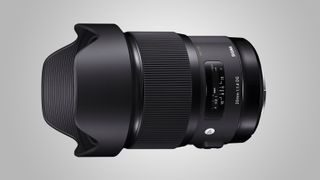
6. Sigma 20mm f/1.4 DG HSM | Art
Specifications
Reasons to buy
Reasons to avoid
With a short 20mm focal length, this lens goes extra-large on viewing angle while retaining the same f/1.4 aperture rating as most other Sigma ‘Art’ series prime lenses. It’s actually the world’s first ultra-wide lens to achieve this, by using a large-diameter double aspherical element that poses a significant manufacturing challenge. The optical path includes two FLD (Fluorite-grade Low Dispersion) elements and no less than five SLD (Special Low Dispersion) elements, aiming to deliver excellent sharpness and contrast, with minimal colour fringing. Build quality is excellent although, as with most other Sigma Art lenses, weather-seals are not featured. There’s no getting away from the fact that the wide viewing angle combined with a wide aperture rating result in a big build, and it’s the heaviest lens in the group at nearly a kilogram. There’s a built-in lens hood to protect the large, bulbous front element, but this precludes the use of regular screw-in filters or filter holders. Help is at hand from Lee Filters, who make a dedicated adaptor for use with its SW150 Mk II filter system. For such an ultra-wide-angle lens, sharpness is superb across the whole frame. Color fringing is fairly minimal and barrel distortion has quite a regular shape that’s easy to correct during image editing.
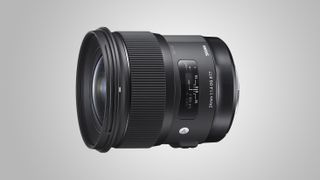
7. Sigma 24mm f/1.4 DG HSM | Art
Specifications
Reasons to buy
Reasons to avoid
Much smaller and lighter than the Sigma 20mm Art lens, this 24mm optic is barely any bigger than the Sigma 35mm and exactly the same weight. Unlike the 20mm lens, this one comes with a separate hood and has a filter attachment thread. Build quality is excellent, the ring-type ultrasonic autofocus system is fast and whisper-quiet, and the manual focus ring operates with smooth precision. Again, there are no weather seals but, like the other Sigma lenses featured, this one is compatible with Sigma’s optional USB Dock, for applying firmware updates and customisation. Up-market glass includes three FLD (Fluorite-grade Low Dispersion) elements and four SLD (Special Low Dispersion) elements, as well as two aspherical elements. As in other Sigma lenses, Super Multi-Layer Coatings are applied to combat ghosting and flare. Edging ahead of most competing lenses, the Sigma 24mm delivers fabulous sharpness across the whole image frame, from the centre to the extreme edges. Color fringing and barrel distortion are relatively negligible. All in all, it’s a top performer.
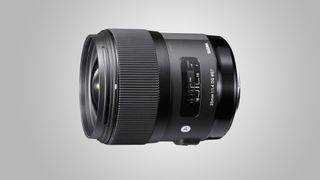
8. Sigma 35mm f/1.4 DG HSM | Art
Specifications
Reasons to buy
Reasons to avoid
Some of Sigma’s f/1.4 ‘Art’ lenses are notoriously big and heavy, including the 20mm, 50mm and 85mm editions. Like the Sigma 24mm lens also featured, this one is more manageable yet retains the same, fast f/1.4 aperture rating. Build quality and finish are immaculate although the lens isn’t weather-sealed. Autofocus is fast and very quiet, while manual focusing is super-smooth and precise. There’s a generous amount of rotational travel and the focus ring itself is comfortably large. The Sigma goes extra-large in terms of performance. Image quality is absolutely fabulous, with epic sharpness across the whole frame, while colour fringing and distortion are negligible. It’s the least ‘wide-angle’ of Sigma’s current wide primes but the 35mm focal length is preferred by many photographers for its relatively natural perspective.

9. Tamron SP 35mm f/1.8 Di VC USD
Specifications
Reasons to buy
Reasons to avoid
Tamron’s recently launched 35mm, 45mm and 85mm ‘super performance’ prime lenses all combine a fairly fast f/1.8 aperture and highly effective image stabilization. This is naturally the most ‘wide-angle’ lens of the three, and the widest prime lens that Tamron currently markets. Physically, it’s a little wider but shorter than the competing Sigma 35mm lens, and noticeably lighter at 480g compared with 665g. Build quality feels almost as good as in the Sigma lens, but the Tamron has the additional benefit of weather-seals. As with the Sigma lens, the Tamron is compatible with an optional USB docking station, which Tamron calls a ‘Tap-in Console’. Again, this enables you to connect the lens to a computer and apply fine-tuning as well as firmware updates. Image quality is very impressive overall, with particularly nice bokeh. However, the Tamron isn’t quite as sharp as the Sigma, across all regions of the image frame. Color fringing and barrel distortion are marginally worse but still well controlled. Overall, the Tamron is an excellent lens and a top choice if you feel the need for weather-seals and image stabilization.

10. Zeiss Milvus 2/35mm
Specifications
Reasons to buy
Reasons to avoid
Unlike the vast majority of modern lenses, the Milvus is typical of most Zeiss optics in that it’s a manual-focus affair with no autofocus facility. It’s beautifully styled, immaculately engineered with a metal barrel, and certainly feels very robust, complete with weather-seals. However, it’s relatively heavy for a 35mm f/2 lens. Manual focusing is actually quite a joy thanks to the silky-smooth focus ring. Depth of field markings are on hand f/4, f/8, f/16 and f/22, so you can easily apply ‘zone focusing’ to keep any given area of a scene rendered sharply. Another focusing aid is that built-in electronics enable the focus confirmation lamp to be illuminated in the camera’s viewfinder. Sharpness is very good rather than completely great. Contrast and color quality are excellent but the lens lags behind some competitors for control over colour fringing and barrel distortion.
- 1
- 2
Current page: Best wide-angle prime lenses for Nikon DSLRs
Prev Page Best wide-angle prime lenses for Canon DSLRsGet daily insight, inspiration and deals in your inbox
Get the hottest deals available in your inbox plus news, reviews, opinion, analysis and more from the TechRadar team.
